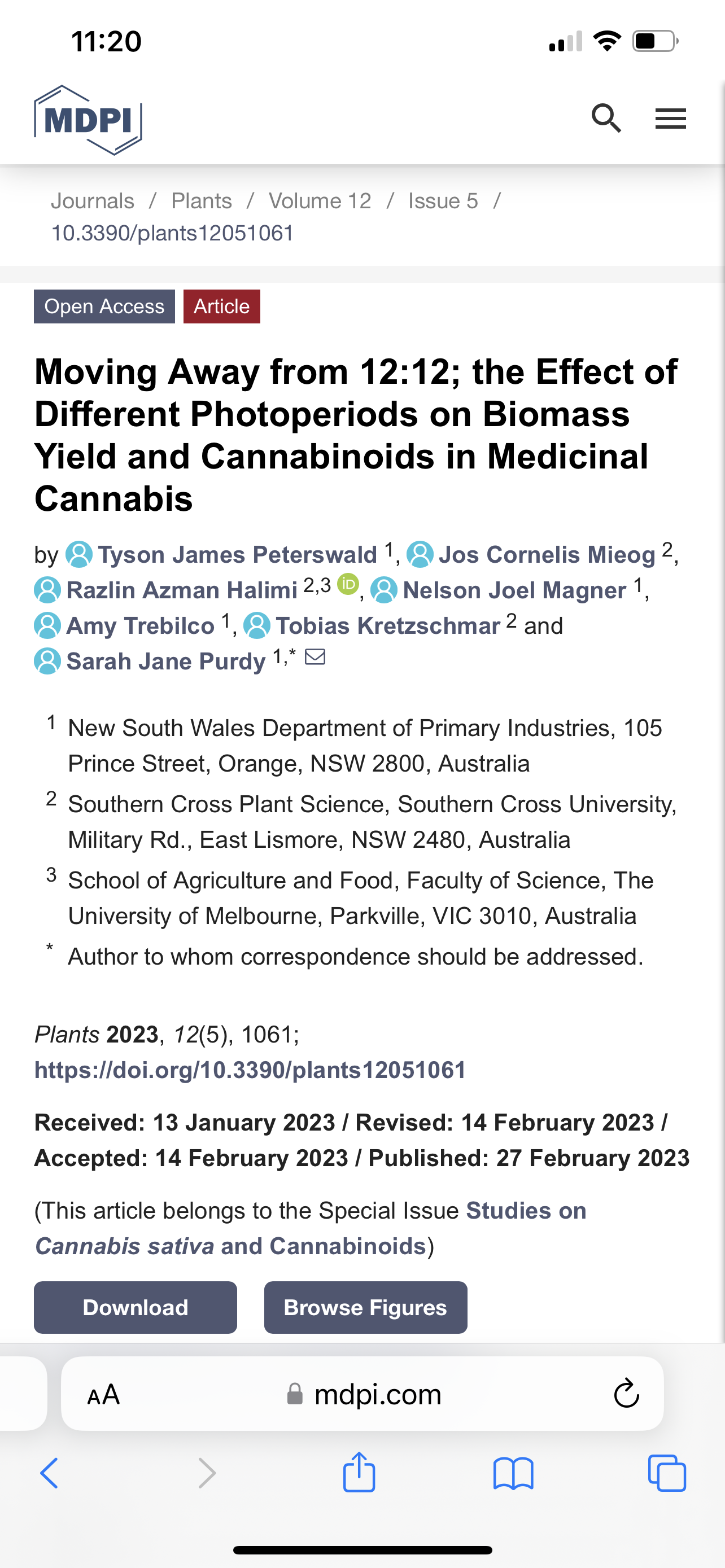The Optimal Cannabis Flower Photoperiod: It’s not 12/12….
May 26 2023 – Danielle Daly

Welcome to our ongoing blog series, originally crafted on Instagram, where we explore the intriguing world of flower photoperiod research. Have you ever wondered if a photoperiod of 14 hours on and 10 hours off for the initial 28 days, followed by 12 hours of light and 12 hours of darkness for the last 28 days, could become the new standard for flowering plants?
According to an intriguing study, the results hint at an increase in yield and a THC percentage that remains consistent. While one study isn't conclusive, the research was meticulously conducted and makes a compelling case for consideration. Interestingly, maintaining a photoperiod of 14 hours on and 10 hours off throughout the flowering stage showed the most significant yield gains, albeit with a slight drop in THC percentage.
Here's a closer look at the study's key findings:
The Study Details:
- The study examined three different varieties: 'Cannatonic,' known for its high CBD accumulation, alongside 'Northern Lights' and 'Hindu Kush,' both high-THC varieties.
Results and Observations:
- The research revealed variations in how the three varieties responded to different light treatments.
- Notably, the high-CBD line ('Cannatonic') demonstrated a remarkable doubling of cannabinoid yield when subjected to an early 14-hour light (14L) photoperiod compared to the conventional 12-hour light (12L) period.
- In contrast, one of the high-THC lines ('Northern Lights') saw a 50% yield increase with the 14L < 12L treatment, while the other high-THC line ('Hindu Kush') didn't exhibit any significant yield effects.
To summarize the study's intriguing findings, it was observed that increasing the photoperiod during the flowering phase from 12 hours to 14 hours could more than double cannabinoid yields, as demonstrated by the 'Cannatonic' line. Furthermore, a 14-hour light (14L) photoperiod, which utilizes the same number of light hours as the standard 12-hour light (12L) period and incurs no additional electricity costs, proved beneficial for high-THC lines as well. This newfound 'all-round treatment' may hold the key to maximizing cannabinoid production without sacrificing THC content or incurring significant energy expenses.
As this study challenges the established norms, it encourages us to rethink our flowering strategies and explore innovative approaches. Stay tuned for more insights as we continue to investigate the fascinating realm of photoperiod research in plant cultivation. 🌱💡
𝐓𝐡𝐞 𝐬𝐭𝐮𝐝𝐲
The three varieties used in the study were: 'Cannatonic,' a high CBD-accumulating line, as well as 'Northern Lights' and 'Hindu Kush,' two high THC varieties.
𝐑𝐞𝐬𝐮𝐥𝐭𝐬
"Most significantly, the high-CBD line (Cannatonic) showed cannabinoid yield increased to more than double when an early 14L photoperiod was applied compared to the standard 12L. In contrast, one of the two high-THC lines tested (Northern Lights) only showed a 50% yield increase in the 14L < 12L treatment, whereas the second high-THC line tested (Hindu Kush) did not show any significant yield effects."
"In particular, cannabinoid yields can be more than doubled by increasing the photoperiod during the flowering phase from 12 h to 14 h, as demonstrated by the Cannatonic line. A 14L > 10L photoperiod also achieved a strong yield benefit which utilizes the same number of light hours as 12L and therefore incurs no extra electricity costs. 𝐅𝐨𝐫 𝐨𝐧𝐞 𝐡𝐢𝐠𝐡-𝐓𝐇𝐂 𝐥𝐢𝐧𝐞, 𝐚 𝟏𝟒𝐋 > 𝟏𝟐𝐋 𝐩𝐡𝐨𝐭𝐨𝐩𝐞𝐫𝐢𝐨𝐝 𝐢𝐧𝐜𝐫𝐞𝐚𝐬𝐞𝐝 𝐓𝐇𝐂 𝐲𝐢𝐞𝐥𝐝𝐬 𝐛𝐲 𝟒𝟗%, 𝐝𝐫𝐢𝐯𝐞𝐧 𝐛𝐲 𝐚 𝐠𝐚𝐢𝐧 𝐢𝐧 𝐛𝐢𝐨𝐦𝐚𝐬𝐬 𝐨𝐧𝐥𝐲 (𝐧𝐨 𝐜𝐡𝐚𝐧𝐠𝐞 𝐢𝐧 % 𝐓𝐇𝐂), 𝐰𝐡𝐞𝐫𝐞𝐚𝐬 𝐚 𝐬𝐞𝐜𝐨𝐧𝐝 𝐡𝐢𝐠𝐡-𝐓𝐇𝐂 𝐥𝐢𝐧𝐞 𝐝𝐢𝐝 𝐧𝐨𝐭 𝐬𝐡𝐨𝐰 𝐚𝐧𝐲 𝐬𝐢𝐠𝐧𝐢𝐟𝐢𝐜𝐚𝐧𝐭 𝐝𝐢𝐟𝐟𝐞𝐫𝐞𝐧𝐜𝐞𝐬. 𝐀𝐬 𝐭𝐡𝐢𝐬 𝐭𝐫𝐞𝐚𝐭𝐦𝐞𝐧𝐭 𝐚𝐥𝐬𝐨 𝐛𝐞𝐧𝐞𝐟𝐢𝐭𝐭𝐞𝐝 𝐂𝐚𝐧𝐧𝐚𝐭𝐨𝐧𝐢𝐜, 𝐭𝐡𝐢𝐬 𝐦𝐚𝐲 𝐛𝐞 𝐭𝐡𝐞 𝐛𝐞𝐬𝐭 '𝐚𝐥𝐥-𝐫𝐨𝐮𝐧𝐝' 𝐭𝐫𝐞𝐚𝐭𝐦𝐞𝐧𝐭 𝐨𝐩𝐭𝐢𝐦𝐚𝐥 𝐟𝐨𝐫 𝐦𝐢𝐱𝐞𝐝 𝐜𝐮𝐥𝐭𝐢𝐯𝐚𝐭𝐢𝐨𝐧 𝐚𝐧𝐝 𝐮𝐧𝐭𝐞𝐬𝐭𝐞𝐝 𝐯𝐚𝐫𝐢𝐞𝐭𝐢𝐞𝐬,"

0 comments